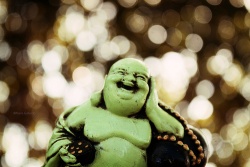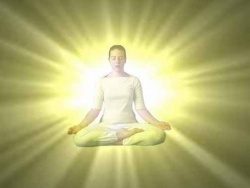Destructive emotions

- See also :
- See also :
Destructive emotions (Skt. kleśa; Tib. nyönmong; Wyl. nyon mongs) — the negative, destructive emotions which are the cause of suffering.
Divisions
- The three main destructive emotions (or three poisons) are ignorance, attachment and aversion.
- When classified as five, pride and jealousy are added (the five poisons). Pride is a combination of ignorance and attachment, and jealousy is a combination of attachment and aggression.
The Abhidharma further categorizes all destructive emotions into:
Causes of Destructive Emotions
In the Abhidharma it says there are three main causes of negative emotions:
- Not having abandoned the latent tendencies or predispositions (nyon mongs pa’i bag la nyal ma spang)
- Coming into contact with a provocative object (nyon mongs skye ba’i yul nye bar gnas pa)
- Incorrect thinking or an unhelpful attitude (tshul bzhin ma yin pa’i yid la byed pa)
Working with Destructive Emotions
His Holiness the Dalai Lama has said that there are three reasons for believing that the destructive emotions can be eliminated from our minds:
- All the destructive emotions and mental states are essentially distorted, whereas the antidotes, such as love, compassion and insight, are undistorted and based on how things really are.
- The antidotes have the quality of being strengthened through training and practice.
- The essential nature of the mind is pure and undefiled by the destructive emotions.
Ringu Tulku Rinpoche says:
- "Ignorance is the most fundamental of the kleshas, but also the most difficult to work with, so we need to begin with our attachment and aversion.
- Traditionally the teachings begin with attachment, but I think it is easiest to begin with anger or aversion. Attachment is so strong in us we are not really ready to work on it. Of course, if we can deal with attachment then aversion is taken care of automatically, whereas dealing with aversion will not necessarily rid us of attachment. But most people are not prepared to work on their attachment straight away, although they can quite easily see how anger and aversion are destructive and unpleasant.
- In a sutra it says this very clearly. It says that of the three poisons, ignorance is the most basic and pervasive. It is like the earth. If we can rid ourselves of this, we will rid ourselves of all the negative emotions, but this is difficult precisely because it is so deep and fundamental.
- Yet ignorance does not cause us acute pain or present immediate difficulties, nor will it throw us into the hells. So we can deal with it more slowly.
- Then attachment, it says, is like water: it is very pervasive. It causes us pain and suffering and it is not easy to get rid of. Attachment is not all bad—it has both a negative and positive side, e.g. compassion and love, or the resolution to become enlightened. We can be a little patient with this too. Water takes a long time to dry up.
- Aversion is compared to fire. It has almost no positive side. Wishing harm for others will always bring us suffering for others and for ourselves too. Aversion then is where we must begin. It has the quality of a flame: it bursts up very quickly and can burn away everything, but when the fuel is no longer there it will go down again just as quickly."
According to the Different Yanas
In the Hinayana, the shravakas and pratyekabuddhas abandon [destructive] emotions or bring them to cessation. In the causal vehicles of philosophy, the bodhisattvas purify them. In Mantra, the followers of the Outer Tantras transform (destructive emotions) while the followers of the Inner Father and Mother Tantras[1] take control of them. For a practitioner of Atiyoga, the object of abandonment and its remedy are of one taste.[2]
Translation
Alternative Translations
- Negative emotions
- Disturbing emotions
- (Mental) Afflictions (B. Alan Wallace)
- Defiled emotions
- Afflictive emotions
- Kleshas
- Dissonant emotions (Gyurme Dorje and Thupten Jinpa)
- Dissonant mental states (Gyurme Dorje and Graham Coleman)
- Passions (Sangye Khandro following Dungse Thinley Norbu)
Definition
- From the Great Tibetan Dictionary (bod kyi tshig mdzod chen mo):
mi dge ba'i las bskul bas rang rgyud rab tu ma zhi bar byed pa'i sems byung
“mental events that incite one to unvirtuous actions and cause one’s being to be very [unpeaceful]”[3]
- From the Great Dictionary:
lus sems gdung ba'i dka' las sam ngal dub dang, mi dge ba'i las bskul bas rang rgyud rab tu ma zhi bar byed pa'i sems byung,
“a mental state that afflicts the body and mind with difficulty and fatigue and makes one’s being extremely ill at ease by inciting one to unwholesome actions.”
Comments
Some translators prefer not to translate nyon mongs as emotion, because, as they point out, we would not immediately think of delusion and doubt, for example, as being ‘emotions’.
Footnotes
- ↑ In the Nyingma tradition, these inner tantras correspond to the Mahayoga and Anuyoga tantras.
- ↑ Jokyab Rinpoche in Light of Wisdom, Vol. Two, translated by Erik Pema Kunsang (Boudhanath: Rangjung Yeshe Publications, 1986-98), pages 157-158.
- ↑ quoted in Jamgön Kongtrul and Khenchen Thrangu Rinpoche, Creation and Completion, Essential Points of Tantric Meditation, Translated by Sarah Harding (Boston: Wisdom Publications, 1996-2002), page 156, note 8.



